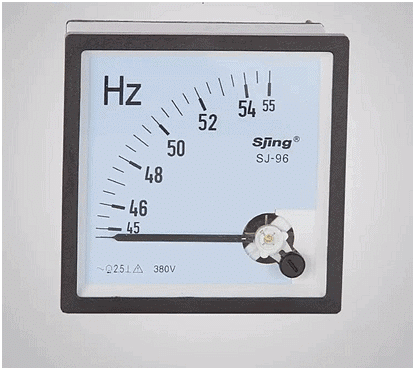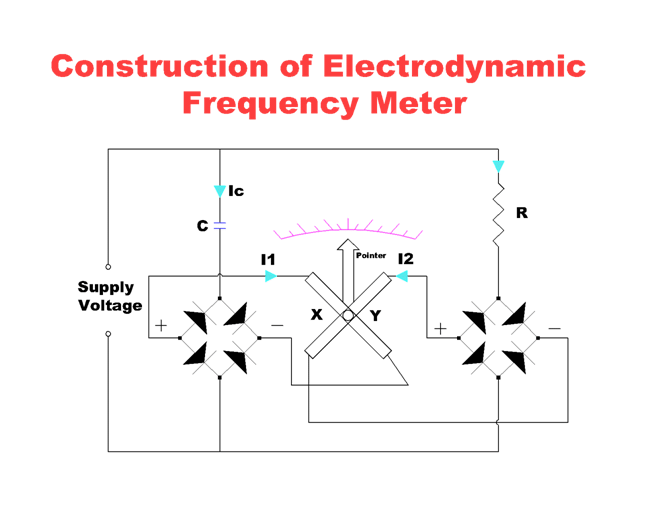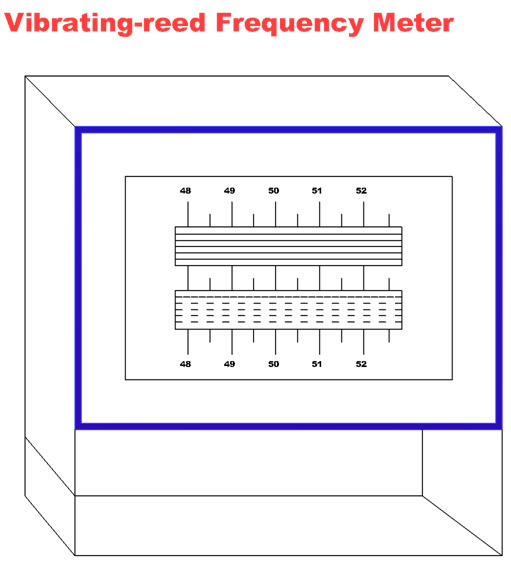Frequency Meter | Electrical and Electronic Measurements - Electrical Engineering (EE) PDF Download
| Table of contents |

|
| What are Frequency Meters? |

|
| Moving Iron Frequency Meter |

|
| Electrodynamic Frequency Meter |

|
| Vibrating Reed Frequency Meter |

|
What are Frequency Meters?
Frequency meters are tools that show how often electrical energy changes. This energy can be from things like electricity in homes or signals in devices. A moving coil frequency meter works by looking at the changes in electric current in different types of circuits. When the current in these circuits changes, the meter can tell us the frequency.
There are different kinds of frequency meters:
- Moving Iron Frequency Meter
- Electrodynamic Frequency Meter
- Vibrating Reed Frequency Meter

Moving Iron Frequency Meter
Moving iron frequency meters are devices where two coils are fixed, and a piece of iron moves along with a spindle. These meters work based on the following principle.
Working Principle
These meters work by looking at changes in electric current in two types of circuits, called inductive and non-inductive circuits. These circuits are connected together, and when the frequency changes, the electric current in these circuits changes too.
Parts
The meter has two fixed coils named A and B, with their magnetic axes at right angles to each other. There's a long, soft iron needle pivoted at their centers. This setup stays balanced at the frequency we want to measure. Coil A has a series of resistance (Ra) and a reactance (La) connected in parallel, while coil B has a series of resistance (Rb) and a reactance (Lb) also connected in parallel. The series of reactance helps to reduce extra waves in the current, which makes the meter show the right values.
How it Works
When we connect the meter to the supply, the electric current flows through coils A and B, creating opposite twisting forces (torques). When the supply frequency goes up, the current in coil A increases and the current in coil B decreases. This makes the iron needle move closer to coil A's magnetic axis. When the frequency is low, the current in coil B goes up, and in coil A it goes down.
Range
These meters are made to measure both high and low frequencies, from large amounts to very small ones.
Electrodynamic Frequency Meter
Electrodynamic frequency meters, also known as moving coil frequency meters, are a type of tool that measures frequency. They are used for both high and low voltage ranges and give accurate results. These meters are made up of two moving coils and a rectifier circuit.
Parts
This type of frequency meter has two moving coils connected to each other at right angles on a shaft. A pointer is attached to this shaft. Both moving coils are linked with bridge rectifiers. There's also a capacitor in series with the bridge rectifier of the first moving coil, connected to a DC supply. The rectified current flows through a series resistance to the bridge rectifier and to the second coil.
Range
The ranges of these meters depend on the resistance and capacitor values. They can measure frequencies from 40 to 60 Hz, 1200 to 2000 Hz, and 8000 to 12000 Hz.
How it Works
When the frequency is connected to the meter, the rectified currents (I1 and I2) flow through the moving coils C1 and C2. As these coils come to rest, their torques become equal but in opposite directions.
Advantages
- These meters have frequency scales that are linear.
- The readings are not affected by voltage changes.
- They can be used across a wide range of voltages, including very low voltage ranges.
Disadvantages
- The rectifiers can create distortions, leading to inaccurate frequency readings.
 |
Download the notes
Frequency Meter
|
Download as PDF |
Vibrating Reed Frequency Meter
A vibrating reed frequency meter is a device used to find out how fast electric circuits change, known as frequency. It has 7 reeds that vibrate at different rates, and the one that vibrates the most tells us the frequency of the electric circuit.
Parts
This meter has thin, flat steel reeds lined up close to an electromagnet. The electromagnet has a layered armature with a winding connected to a resistance. This winding is linked to the AC supply whose frequency we want to measure. The metallic reeds are 4mm wide and 0.5 mm thick. They're lined up in order of frequency on a scale, with a flexible base to hold the armature of the electromagnet. These reeds are colored white.
Range
These meters can measure frequencies from 47 Hz to 53 Hz, and from 57 Hz to 63 Hz.
How it Works
To measure the frequency, we have to connect the meter to a power supply. The electromagnet is then connected to the supply we're measuring. The magnetism of the electromagnet switches back and forth at the same frequency, pulling on each reed once every half cycle. All reeds start vibrating, but the one with double the frequency vibrates the most because of mechanical resonance. The other reeds vibrate very little, so we don't notice them.
Advantages
- The readings are reliable.
- It's affordable.
- The readings don't depend on anything else.
Disadvantages
- Sometimes it's hard to see the reading if the frequencies of neighboring reeds are too close.
- The instrument might not always give an exact reading on its scale.
|
48 videos|39 docs|22 tests
|















